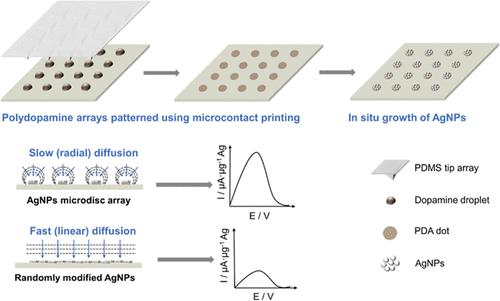银微盘阵列电极芯片用于慢性肾炎患者唾液尿素检测
IF 6.7
1区 化学
Q1 CHEMISTRY, ANALYTICAL
引用次数: 0
摘要
尿素是诊断各种肾脏和肝脏疾病的重要生物标志物。然而,许多现有的方法依赖于侵入性血液采样,这可能会对患者造成潜在的伤害。唾液最近被认为是一种无创且易于收集的尿素定量血液替代品。唾液中尿素的电化学检测仍然是有限的,催化材料通常通过滴铸作用于电极表面。这导致材料的随机分布和电极上的电位聚集,不可避免地阻碍了分析物的有效传质,降低了检测灵敏度和催化材料的利用率。本文通过在聚多巴胺(PDA)阵列上原位生长银纳米粒子(AgNP)制备了集成银纳米粒子(AgNP)的微盘阵列电极芯片,并利用微接触印刷(μCP)技术在氧化铟锡(ITO)玻璃基板上进行了图形化处理。与传统的滴铸电极相比,该AgNP微圆盘阵列芯片传感器表现出更高的尿素传感灵敏度和更高的材料利用率,因为它增强了传质。此外,芯片传感器在受到潜在干扰时表现出优越的选择性。更重要的是,在肾炎患者的临床唾液样本中实现了可靠的尿素定量。这些结果表明,目前的传感器为开发一种无创、灵敏的尿素检测液体活检平台提供了巨大的机会,用于临床诊断应用。本文章由计算机程序翻译,如有差异,请以英文原文为准。

Silver Microdisc Array Electrode Chip for Urea Detection in Saliva Samples from Patients with Chronic Nephritis
Urea is an important biomarker for diagnosing various kidney and liver disorders. However, many existing methods rely on invasive blood sampling, which can potentially harm patients. Saliva has been recently recognized as a noninvasive and easily collectible alternative to blood for urea quantification. Electrochemical urea detection in saliva remains limited, with catalytic materials typically applied to the electrode surface via drop casting. This results in a random distribution of materials and potential aggregation on the electrode, which inevitably hinders the efficient mass transport of analytes, reducing both detection sensitivity and the utilization of catalytic materials. In this work, a silver nanoparticle (AgNP)-integrated microdisc array electrode chip was fabricated through the in situ growth of AgNPs on polydopamine (PDA) arrays, which were patterned using the microcontact printing (μCP) technique on an indium tin oxide (ITO) glassy substrate. The resulting AgNP microdisc array chip sensor exhibited much higher sensitivity toward urea sensing and greater material utilization as compared to traditional drop-cast electrodes, due to the enhanced mass transfer. Furthermore, the chip sensors demonstrated superior selectivity when challenged with potential interferences. More importantly, reliable urea quantification was achieved in clinical saliva samples from nephritis patients. These results indicate that the current sensor presents great opportunities for developing a noninvasive and sensitive liquid biopsy platform for urea determination in clinical diagnosis applications.
求助全文
通过发布文献求助,成功后即可免费获取论文全文。
去求助
来源期刊

Analytical Chemistry
化学-分析化学
CiteScore
12.10
自引率
12.20%
发文量
1949
审稿时长
1.4 months
期刊介绍:
Analytical Chemistry, a peer-reviewed research journal, focuses on disseminating new and original knowledge across all branches of analytical chemistry. Fundamental articles may explore general principles of chemical measurement science and need not directly address existing or potential analytical methodology. They can be entirely theoretical or report experimental results. Contributions may cover various phases of analytical operations, including sampling, bioanalysis, electrochemistry, mass spectrometry, microscale and nanoscale systems, environmental analysis, separations, spectroscopy, chemical reactions and selectivity, instrumentation, imaging, surface analysis, and data processing. Papers discussing known analytical methods should present a significant, original application of the method, a notable improvement, or results on an important analyte.
 求助内容:
求助内容: 应助结果提醒方式:
应助结果提醒方式:


